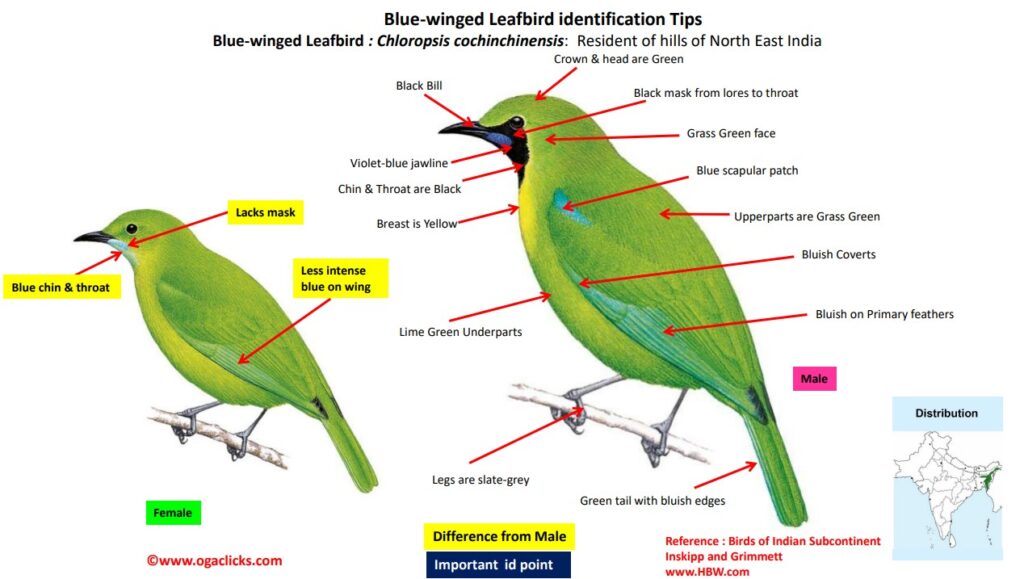
Blue-winged Leafbird Chloropsis moluccensis Chlorocephala
Etymology:
- Chloropsis: Greek word khlros – green; opsis-appearance.
- Moluccensis: From Maluku provinces, Indonesia, formerly known as the Spice Islands
- Chlorocephala : Greek word khlōros green, kephalos -headed (Green Headed)
Vernacular Names : Hindi: Harewa, Sans: Patragupt, Cachar: Dao-bulip gurrimo, Guj: Jerdon-no harevo, Lilo harevo, Mar: Harewa, Te: Wanna bojanum, Te: Pachchaku pitta, Mal: Ilakili, Kan: Yele hakki, Sinh: Nil-kurulla, Gira-kurulla
Distribution : Size of 15·8–17·7 cm; weight of male 20–28·5 g, weight of female 19–25 g .The male of nominate race has black mask from lores to throat, enclosing short, intensely violet-blue jawline flash and partly enclosing eye, shape of bib is individually variable. It has rich yellow on rest of head, back onto nape and narrowing progressively down onto upper breast, with bronzy wash on nape. The rest of upperparts are grass-green; lesser wing-coverts are royal blue; outer webs of secondary-coverts are narrowly edged green. The tertials and secondaries and whole carpus, alula, primary-coverts and primaries are bright royal blue, blue on tail. It has lime green below bib and rest of underparts, slightly lighter than upperparts. The iris is brown to red-brown; bill is black, or with slaty lower mandible; feet is grey. The female lacks mask has slightly less intense blue on wing and tail, pale bluish chin and throat merging with blue of jawline flash, and brassy-tinted nape and upper back. The Juvenile is like female, but has greener throat and no jaw flash, less blue on wings, and paler bill.
Races vary mainly in details of coloration and pattern of male head and breast, and tone of blue colours: chlorocephala is found from Eastern Himalayan foothills from northeastern India has Green overall with extensive glossy, turquoise-blue in outer wing-feathers
Habitat: It is found in canopy and edge of evergreen and semi-evergreen forests, peat swamp-forest, well-grown secondary forest and nearby mixed orchards. It is found at plains level and on slopes to 1800 m in India.
Food habits: It eats arthropods, fruits, probably also nectar. The Arthropods are gleaned from foliage.. Small fruit items eaten directly; medium-sized, tough-coated items are pierced, and the contents then loosened and squeezed out by using the bill.
Breeding habits: They breed in Apr–Jul in NE Indian Subcontinent; . The nest is an open hammock-type made of tendrils, dry grasses, “rootlets” and the odd tree leaf, heavily camouflaged with bryophytes and lichens, felted externally with cobweb, suspended from rim between twigs or fork prongs towards outer end of lateral branch. They lay a clutch of 2-3 eggs, The incubation period is 13·5 days.